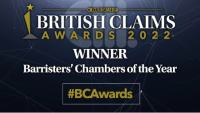<!-- wp:paragraph {"align":"center"} -->
<p class="has-text-align-center"><strong><em>A Local Authority v Mother & Ors</em></strong></p>
<!-- /wp:paragraph --><!-- wp:paragraph {"align":"center"} -->
<p class="has-text-align-center">[2022] EWHC 2793 (Fam)<a href="#_ftn1" id="_ftnref1">[1]</a></p>
<!-- /wp:paragraph --><!-- wp:paragraph {"align":"center"} -->
<p class="has-text-align-center"><strong>Rajni Virk, Pupil Barrister</strong></p>
<!-- /wp:paragraph --><!-- wp:paragraph -->
<p><strong><em>In this interesting recent authority Mr Justice Williams granted an application to reopen findings of fact in a case centring on allegations of serious non accidental injury. There had been significant non-compliance with Ground Rules, such that there had not been a fair hearing. Further there was fresh evidence in the form of cognitive assessment and a further intermediary report that (had it been available at the fact find hearing) would likely have led to both parents having an intermediary. This article considers this decision and practical issues that arise.</em></strong><strong></strong></p>
<!-- /wp:paragraph --><!-- wp:paragraph -->
<p><strong>Background</strong></p>
<!-- /wp:paragraph --><!-- wp:paragraph -->
<p>Mr Justice Williams heard an application to re-open a fact finding judgment made by HHJ Blackhouse in December 2018. HHJ Blackhouse heard a fact-finding hearing in respect of 3 children, A, B and C. Child C was found to have suffered injuries causing them to have subdural and retinal haemorrhages. At the fact find hearing findings were sought that the injuries were inflicted by one of the parents shaking him. Additional findings were sought on additional issues, including failure to seek timely medical attention, inadequate feeding, neglect and substance misuse.</p>
<!-- /wp:paragraph --><!-- wp:paragraph -->
<p>The parents did not accept any of the most serious findings sought. HHJ Blackhouse found the injuries were inflicted to C but could not determine which parent was the perpetrator. She did not accept the parents’ explanation that the injuries were caused to C by bumping him down the stairs of their flat in a buggy or by a toy being thrown by another child. She did not conclude that either parent was covering up for the other.</p>
<!-- /wp:paragraph --><!-- wp:paragraph -->
<p>As a result of these findings, care and placement orders were made for all three children. Final orders were made in June 2019. In late 2019, the parents had another child D, she was placed in a foster to adopt placement.</p>
<!-- /wp:paragraph --><!-- wp:paragraph -->
<p>The mother’s first application to re-open the fact-finding judgment was dismissed. However, the mother, in her position statement relating to D’s proceedings, argued that she should be given the opportunity to challenge the findings made in the context of D’s final hearing. This application and the adoption applications for the elder children were consolidated. The final hearing was adjourned to allow for the application (now made by both parents) to be heard in full. Transcripts of the evidence were obtained to inform the Court’s decision.</p>
<!-- /wp:paragraph --><!-- wp:paragraph -->
<p><strong>Mr Justice Williams granted the application by the parents for the findings of fact, in relation to C’s injuries, to be relitigated within the proceedings concerning the younger child D. Following such rehearing, if there were a change of outcome in relation to the causation of injuries or (if inflicted) perpetrator, this would also amount to a change of circumstances in relation to the parents’ application for leave to oppose the adoption of the elder siblings.</strong></p>
<!-- /wp:paragraph --><!-- wp:paragraph -->
<p>Both the mother and father had made arguments that the findings should be reopened, criticising the approach taken to the expert evidence. Arguments included insufficient exploration of mechanism and that an expert had dismissed the potential for the ‘bump down the steps in the buggy’ to have caused the injuries. Attention was drawn to other case law in which this mechanism had been accepted as a possibility. It was said that challenges had not been put in relation to the longevity of birth-related subdural bleeding/retinal haemorrhages nor the possibility of re-bleeding. There were arguments that typical other markers of a shaking injury were absent. Genetic testing had not been undertaken nor testing for EDS type III or 4/connective tissue disorders, despite coagulation testing being taken. The Father made additional arguments in relation to alleged multiple failures to challenge the expert evidence and put the parents’ case. </p>
<!-- /wp:paragraph --><!-- wp:paragraph -->
<p>The arguments made by the parents as to the deficiencies in the expert evidence and the approach taken to it, were dismissed. Mr Justice Williams concluded that it was hard to say that counsel’s criticism of the approach taken to the medical evidence at the fact find hearing could amount to a solid ground for believing that the result might be different. He did not conclude that the transcripts of evidence demonstrated that an approach was taken by the trial advocates outside the range of reasonable approaches, saying “<em>Although we have not explored the test, which might govern the court reopening a hearing due to the performance of the lawyers, it does not seem to me that we are anywhere close to the realms at which unfairness due to inadequate legal representation is close to engaged.</em>”</p>
<!-- /wp:paragraph --><!-- wp:paragraph -->
<p>The parents both made arguments about the <em>fairness</em> of the hearing. The Mother raised arguments in relation to the issue of an intermediary, including the court’s residual discretion to revisit important decisions which relate to the welfare of children<a href="#_ftn1" id="_ftnref1">[1]</a>. The Mother had also been assessed as currently requiring an intermediary which made it most likely that she required one during the fact-finding hearing, and it was submitted on her behalf that though not every breach of requirements in relation to vulnerable witnesses will lead to re-opening, significant failures will. Concerns were raised in relation to the quality of Dr Mann’s report (cognitive assessment). The main consideration was the failure in the process, which ultimately led to an unfair hearing. Though the initial report did not identify the need for an intermediary, it did clearly set out guidance that should be considered such as explanation of unfamiliar or complex words, avoiding statements, use of simple language and need for hourly breaks, which were not complied with. Finally, it was argued that the court must review whether the mother was able to participate in the proceedings adequately<a href="#_ftn2" id="_ftnref2">[2]</a>.</p>
<!-- /wp:paragraph --><!-- wp:paragraph -->
<p>The Father’s arguments in support of the application centred on serious procedural unfairness and it was submitted that it was not for him to establish whether there are grounds for believing a rehearing will result in different findings. The right to a fair hearing is absolute, and the vulnerable witnesses provisions are designed to ensure a fair hearing. The provisions of Part 3A and PD3AA of the FPR 2010 were in force and should have been considered. Particular attention was drawn to <strong><em>Re N (A Child) </em>[2019] EWCA Civ 1997</strong>; <em>“A wholesale failure to apply the Part 3 procedure to a vulnerable witness must, in my mind, make it highly likely that the resulting trial will be judged to have been unfair”.</em> </p>
<!-- /wp:paragraph --><!-- wp:paragraph -->
<p>There was fresh evidence given by Dr Radcliffe and Ms Turner (who completed a cognitive and intermediary assessment respectively), from which it was argued the court can conclude the father was prejudiced in his participation. Ms Turner’s assessment identified the difficulties the father has in concentrating over longer periods and the overall impact of these reports called into question the father’s ability to give full instructions to his team in 2018/19 in matters arising from the expert evidence. </p>
<!-- /wp:paragraph --><!-- wp:paragraph -->
<p>There was an order in 2018 which set out 5 Ground Rules which were not implemented. Though the judgment referred to the Ground Rules, albeit briefly (nor was it shown in the transcript), the role of Part 3A FPR 2010 was not referred to in the note of the law, and neither did the impact of cognitive functioning feature in the judge’s evaluation of evidence. </p>
<!-- /wp:paragraph --><!-- wp:paragraph -->
<p>Neither the advocates nor the judge seemed to make use of the Advocate’s Toolkit. As the court had not appointed an intermediary, it was argued that the onus is on the court to ensure the Ground Rules are even more pronounced. Finally, the father had no breaks during the evidence which included complex medical concepts, save for a 10-minute lunch break during his own evidence.</p>
<!-- /wp:paragraph --><!-- wp:paragraph -->
<p>Though the Local Authority accepted that the correctness of the findings was of fundamental importance to the adoption of the children, it maintained that the medical evidence justified a finding that C’s head injury was caused by being shaken. In respect of the issues surrounding intermediaries, the Local Authority accepted the guidance from <strong><em>Re N (A Child)</em></strong>, but argued that a partial failure does not invariably lead to success on appeal. It was argued that the question on appeal is whether there is a serious procedural irregularity which renders the decision unjust. There was no specific finding against either parent in this case and it could not be determined that the judge’s assessment of credibility was crucial to the outcome. They argued therefore that the lack of engagement with the Ground Rules did not lead to the conclusion that the parents’ evidence was materially impacted by this. In any event, the transcript showed that some measures were used, such as breaks, simple language and the judge asking the father slow down.</p>
<!-- /wp:paragraph --><!-- wp:paragraph -->
<p>Though there was a change in the Guardian and their legal team, it was submitted that based on all the authorities, the test for the court to apply is to look at all the circumstances of the case to determine whether the trial was fair. It was put forward that a failure to comply with Part 3A of the FPR 2010 did not give automatic rise to a successful appeal, but rather the court must consider whether it amounts to a serious procedural irregularity. </p>
<!-- /wp:paragraph --><!-- wp:paragraph -->
<p>Williams J considered the written documents and bundle of authorities prepared by the parties. At paragraph 20, Williams J stressed the importance in complying with the Practice Direction on citation of authorities and using the most up to date authoritative, officially reported version of a case as some did not include head notes, summaries of arguments or lists of authorities.</p>
<!-- /wp:paragraph --><!-- wp:paragraph -->
<p>This case was identified as one where vulnerabilities of the parties <em>were</em> raised prior to the fact finding and apparently addressed. For example a cognitive assessment was obtained and later an intermediary assessment. Ground rules were identified. Against that background the question was how the court should approach the application to reopen the findings of fact. Williams J reached the conclusion that the later cognitive and intermediary assessments of the parents should be regarded as fresh evidence and the approach in <strong><em>Ladd v Marshall<a href="#_ftn3" id="_ftnref3"><strong>[3]</strong></a> </em></strong>should be adopted to see if they could have been available earlier, whether they are credible and whether, had they been available, would have had an effect on the decision-making in relation to the Ground Rules.</p>
<!-- /wp:paragraph --><!-- wp:paragraph -->
<p><strong>The Law</strong></p>
<!-- /wp:paragraph --><!-- wp:paragraph -->
<p>Williams J at [23-39] sets out the legal framework to consider in applications of this type. In particular, Williams J identified that the overarching test to apply to applications to reopen findings of fact as:</p>
<!-- /wp:paragraph --><!-- wp:paragraph -->
<p>“<em>49. These decisions establish that there are three stages. First, the court considers whether it will permit any reconsideration of the earlier finding. If it is willing to do so, the second stage determines the extent of the investigations and evidence that will be considered, while the third stage is the hearing of the review itself.”<a href="#_ftn4" id="_ftnref4"><strong>[4]</strong></a></em></p>
<!-- /wp:paragraph --><!-- wp:paragraph -->
<p>At paragraph 27 Williams J set out the process the court should follow when considering ‘Stage 1’ of the test, as outlined by Peter Jackson LJ in <strong><em>Re E</em></strong>:</p>
<!-- /wp:paragraph --><!-- wp:paragraph -->
<p><em>"50. … A court faced with an application to reopen a previous finding of fact should approach matters in this way:</em></p>
<!-- /wp:paragraph --><!-- wp:paragraph -->
<p>(1) <em>It should remind itself at the outset that the context for its decision is a balancing of important considerations of public policy favouring finality in litigation on the one hand and soundly based welfare decisions on the other.</em></p>
<!-- /wp:paragraph --><!-- wp:paragraph -->
<p>(2) <em>It should weigh up all relevant matters. These will include: the need to put scarce resources to good use; the effect of delay on the child; the importance of establishing the truth; the nature and significance of the findings themselves; and the quality and relevance of the further evidence.</em></p>
<!-- /wp:paragraph --><!-- wp:paragraph -->
<p>(3) <em>'Above all, the court is bound to want to consider whether there is any reason to think that a rehearing of the issue will result in any different finding from that in the earlier trial'. There must be solid grounds for believing that the earlier findings require revisiting."</em></p>
<!-- /wp:paragraph --><!-- wp:paragraph -->
<p>On the point of how to treat an application to re-open where there has been a prior assessment of a vulnerable party, which has led to Ground Rules, Williams J had not been taken to, nor found any other authorities that addressed this. The authorities mentioned were about when vulnerabilities had <em>not</em> been identified, which rendered the trial unfair. The key authorities were <strong><em>N (A Child) </em></strong>(as mentioned by father’s legal team) and <strong><em>Re S (Vulnerable Party: Fairness of Proceedings) </em></strong>[2022] EWCA Civ 8.</p>
<!-- /wp:paragraph --><!-- wp:paragraph -->
<p><strong>Decision</strong></p>
<!-- /wp:paragraph --><!-- wp:paragraph -->
<p>In evaluation, Williams J determined that the criteria identified in the authorities, of needing to demonstrate that the finding has actual or potential legal significance, had been met. In this case, not finding that the injury was inflicted, nor that both parents were in the pool would change the legal landscape, thus the outcome of the case. In respect of child D, this would also alter the threshold on which that current application is based upon.</p>
<!-- /wp:paragraph --><!-- wp:paragraph -->
<p>Though a large portion of the submissions on this application were based on the deficiencies in the medical evidence, Williams J stated that it would be “<em>more helpful to identity the argument separately because there is a distinction in the test to be applied to the medical as opposed to the fair hearing arguments</em>.”<a href="#_ftn5" id="_ftnref5">[5]</a></p>
<!-- /wp:paragraph --><!-- wp:paragraph -->
<p>In respect of the arguments surrounding the lack of exploration around the medical matters, Williams J held that transcripts shows that the mechanisms were explored, and the approaches taken were not out the spectrum of reasonable approaches. Williams J held that the decision should be open on those grounds.</p>
<!-- /wp:paragraph --><!-- wp:paragraph -->
<p>Williams J went on to consider the evidence in relation to the intermediary and Communicourt reports. Williams J found that there had not been a fair hearing, albeit not all limbs of the parents’ cases were established. </p>
<!-- /wp:paragraph --><!-- wp:paragraph -->
<p>Williams J’s overall impression from the transcripts was that:</p>
<!-- /wp:paragraph --><!-- wp:paragraph -->
<p><em>59. i) The Ground Rules as to breaks were not consistently adhered to in particular during the expert evidence and during the latter parts of the parents' evidence.</em></p>
<!-- /wp:paragraph --><!-- wp:paragraph -->
<p><em>ii) Whilst one might not necessarily expect the parties to understand all of the medical evidence given the technicalities of some aspects of it which are a challenge for even seasoned judges and lawyers, one would expect them to have the opportunity to understand the implications of it and the implementation of breaks between experts and, indeed, during lengthy sessions of expert evidence, would enable the parties to understand the implications of it and to give instructions accordingly.</em></p>
<!-- /wp:paragraph --><!-- wp:list {"ordered":true,"type":"1","start":60} -->
<ol type="1" start="60"><li><em>The judgment identifies the fact that the parents credibility impacted upon the ultimate conclusions as to the perpetrator. It is also of note that in some respects the judge identified the parties as cooperative or partially credible witnesses. There is some reason to believe that better adherence to Ground Rules, or indeed better Ground Rules might have assisted the parties in giving their evidence and might have affected the views that the judge took of them. How this might eventually play out of course cannot be known. Either the mother or father might emerge as a more or less credible witness at a rehearing and a clear perpetrator might be identified (if the cause of the injury remains inflicted injury) or both parents might remain in a pool of perpetrators with or without failure to protect findings in tandem.”</em></li></ol>
<!-- /wp:list --><!-- wp:paragraph -->
<p>Using the approach as set out in <strong><em>Ladd v Marshall</em></strong><em>, </em>Williams J found at [63] (in relation to the cognitive assessment and intermediary assessments):</p>
<!-- /wp:paragraph --><!-- wp:list {"ordered":true,"type":"i"} -->
<ol type="i"><li>“<em>Clearly this evidence could not have been available at the time of the hearing in late 2018. It has come into existence as a result of the further proceedings. The evidence is clearly credible, coming both from a well-known expert but also from two unrelated intermediaries. In relation to the decision as to the Ground Rules which were put in place in 2018, it seems beyond dispute that they would have been different had this evidence been available.”</em></li></ol>
<!-- /wp:list --><!-- wp:paragraph -->
<p>For reasons which emerged both from the transcripts as to the lack of adherence to the participation directions and because of the impact of the fresh evidence, Williams J concluded that the hearing in 2018 did not provide a fair hearing to the parents. The parents’ application succeeded on Stage 1 of the test set out in <strong><em>Re E</em></strong>. The causation of C’s head injury would be relitigated.</p>
<!-- /wp:paragraph --><!-- wp:paragraph -->
<p><strong>Conclusion</strong></p>
<!-- /wp:paragraph --><!-- wp:paragraph -->
<p>This judgment reconfirms the applicable principles when considering re-opening findings of fact, particularly the test in <strong><em>Re E </em></strong>and the approach set out in <strong><em>Ladd v Marshall</em></strong>. The failings of the first psychological and intermediary report should also alert practitioners as to the importance of highlighting any obvious deficiencies in reports as early in proceedings as possible to try to prevent a recurrence of the problems arising in this case. </p>
<!-- /wp:paragraph --><!-- wp:paragraph -->
<p>Perhaps more importantly, it should draw advocates’ and judges’ attention to the importance of Ground Rules and ensuring they are properly implemented for a fair hearing. The significance of Ground Rules should not be ignored during trials, even when time seems to be ‘pressing on’. All advocates and judges are equally responsible to ensure that the needs of a vulnerable party are met during what may be a pivotal trial, with many life-changing implications.</p>
<!-- /wp:paragraph --><!-- wp:separator -->
<hr class="wp-block-separator has-alpha-channel-opacity"/>
<!-- /wp:separator --><!-- wp:paragraph -->
<p><a href="#_ftnref1" id="_ftn1">[1]</a> <strong><em>A v A Local Authority, Sub Nom “Re S” </em></strong>[2022] EWCA Civ 8 – in this case the first assessments in relation to the parents held that that no specific assistance was required but this was overtaken by a later assessment making clear this was essential for proper participation The Court of Appeal set aside the initial decision.</p>
<!-- /wp:paragraph --><!-- wp:paragraph -->
<p><a href="#_ftnref2" id="_ftn2">[2]</a> Taking into account the overriding objective of the FPR 2010, Part 3A of the FPR 2010 and right to a fair hearing under Article 6 of the ECHR.</p>
<!-- /wp:paragraph --><!-- wp:paragraph -->
<p><a href="#_ftnref3" id="_ftn3">[3]</a> [1954] 1 WLR 1489</p>
<!-- /wp:paragraph --><!-- wp:paragraph -->
<p><a href="#_ftnref4" id="_ftn4">[4]</a> <strong><em>Re E (Children: Reopening Findings of Fact)</em> </strong>[2019] EWCA Civ 1447</p>
<!-- /wp:paragraph --><!-- wp:paragraph -->
<p><a href="#_ftnref5" id="_ftn5">[5]</a> Paragraph 44</p>
<!-- /wp:paragraph -->







